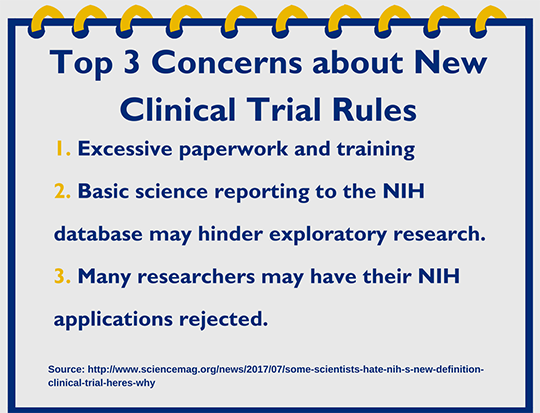The National Institutes of Health’s (NIH) recent change to the definition of a clinical trial will go into effect later this month. The change, done in an effort to restructure and clarify what clinical trials are, will affect NIH grant submission deadlines on or after Jan. 25, 2018.
Redefining Clinical Trails
The NIH now defines a clinical trial as a:
“Research study in which one or more human subjects are prospectively assigned to one or more interventions to evaluate the effects of those interventions on health-related biomedical or behavioral outcomes.”
The new definition includes a broad characterization of an “intervention” as any manipulation of the subject or their environment, which can even include face-to-face interviews. It also broadly defines “outcomes” as any goal or condition in which the effect of the intervention is realized. Under this expanded definition, clinical trials now also include basic research projects that occur outside of the clinic and ones that do not evaluate new treatments. The previous definition was more limited and clinically focused, as evidenced by the NIH National Heart, Lung, and Blood Institute’s previous clinical trial definition, “research studies that explore whether a medical strategy, treatment, or device is safe and effective for humans.” The NIH saw the need to redefine clinical trials to strengthen rigor and transparency, increase the distribution of clinical trial outcomes and improve the effectiveness of federally funded work.

Understanding the New Requirements
This restructuring has large implications for researchers. There are new requirements for grant applications, largely pertaining to selecting the formal funding opportunity announcement (FOA) specifically designated as either required or optional. Scientists who are not aware of the new FOA requirements may not receive funding due to ineligibility or not completing the mandatory Human Subjects and Clinical Trial Information form. There is also mandatory new training for clinical trial staff, and a new procedure to report the trial on the NIH public database.
Implications for Behavioral Research and Basic Science
Some scientists are already unhappy with the comprehensive new definition, especially those in behavioral research fields who are hardest hit by new requirements that now encompass much of their work. For example, functional MRI studies are now mostly considered clinical trials, since measuring brain function is considered an outcome and completing tasks (such as memory games) is considered an intervention, even though these studies are conducted outside of the clinic and provide no formal treatment for participants. More basic science studies will also now be considered clinical trials. Many argue that this will waste resources because of excess paperwork and training required. Others say mandating that trials appear in the public database will only confuse the public, since people searching for relevant trials for therapeutics will be bombarded by irrelevant basic science research.
As the due date for the first funding cycle with the new clinical trial definition looms, only time will tell how the new definition will change the face of research. For now, it is extremely important to understand the new definition, whether ongoing research is now considered a clinical trial and the new regulations and requirements for the study.
Related Content
- Five Tips for Applying for NIH Training Fellowships
- Explore our labs that focus on basic sciences and behavioral research

Who decided to write "irrelevant basic science research." That is very poor word choice.
@J Hamilton, the use of "irrelevant basic science research" was not in any way to make a statement on the relevancy as a whole of basic science research. Basic science research is extremely valuable. The wording was in contrast to "relevant trials for therapeutics". The statement was made specifically in regards to patients exploring the clinical trials database for therapeutic trials, and finding content pertaining to now newly defined clinical trial studies that are not applicable for therapeutic enrollment. I hope this provides clarity, thank you for your comment.
Depth: The dimension of the arch on the skewback which is perpendicular to the arch axis,
except that the depth of a jack arch is taken to be the vertical dimension of the arch at the springing https://math-problem-solver.com/ .
You might deliver batteries and a backup calculator to the check middle.
Comments are closed.